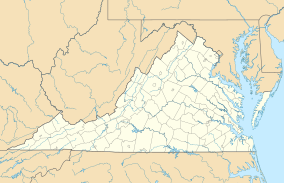| Chestnut Ridge Natural Area Preserve | |
|---|---|
IUCN category V (protected landscape/seascape) | |
| Location | Giles and Bland counties, Virginia |
| Nearest city | Narrows, Virginia |
| Coordinates | 37°17′47″N 80°58′54″W / 37.29634851038942°N 80.98157194066175°W[1] |
| Area | 1,596 acres (646 ha) |
| Established | 2006 |
| Owner | Virginia Department of Conservation and Recreation |
| www | |
Chestnut Ridge Natural Area Preserve is a Natural Area Preserve located in Giles and Bland counties, Virginia. A 1,596-acre (646 ha) tract of old-growth forest, it is dominated by northern red oak and chestnut oak. The extent of unbroken forest on the property is unusual for southwestern Virginia; many of the trees, including cucumber magnolia and American basswood, are between three and four hundred years old.[2]
The preserve was privately owned from its establishment in 2006 until 2020, when the Virginia Department of Conservation and Recreation purchased the property.[3]
In May 2023, the preserve expanded by 775 acres to its current size, adding 1.5 miles of riparian forest along Dry Fork, a stream that contains native trout.[4]
See also
[edit]References
[edit]- ^ "Chestnut Ridge Natural Area". ProtectedPlanet. United Nations Environment Programme's World Conservation Monitoring Centre. Retrieved December 15, 2016.
- ^ "Chestnut Ridge Natural Area Preserve". Virginia Department of Conservation and Recreation. Retrieved 2023-11-11.
- ^ McGarvey, Jason (2023-05-23). "Chestnut Ridge Natural Area Preserve doubles in size". Virginia Outdoors Foundation. Retrieved 2023-11-12.
- ^ Geary, Justin (2023-05-22). "Chestnut Ridge Natural Area Preserve doubling in size". WBDG7. Retrieved 2023-11-12.
External links
[edit]

Well, that’s interesting to know that Psilotum nudum are known as whisk ferns. Psilotum nudum is the commoner species of the two. While the P. flaccidum is a rare species and is found in the tropical islands. Both the species are usually epiphytic in habit and grow upon tree ferns. These species may also be terrestrial and grow in humus or in the crevices of the rocks.
View the detailed Guide of Psilotum nudum: Detailed Study Of Psilotum Nudum (Whisk Fern), Classification, Anatomy, Reproduction